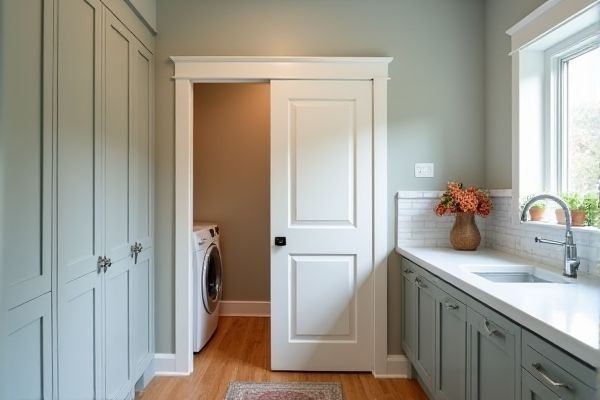
A bifold door pantry offers space-saving convenience by folding neatly against itself, making it ideal for narrow kitchen areas, while a pocket door in a laundry room slides into the wall, providing a sleek, unobtrusive entry that maximizes room space. Explore this article to find out which door option best suits your home's layout and functionality needs.
Table of Comparison
| Feature | Bifold Door Pantry | Pocket Door Laundry Room |
|---|---|---|
| Space Efficiency | Moderate, requires door swing space | High, slides into wall, no swing space needed |
| Installation Complexity | Simple to moderate installation | Complex, requires wall modification |
| Access | Partial to full access depending on panel design | Full access, wide opening available |
| Aesthetic Appeal | Traditional or modern options available | Sleek, minimalist look |
| Cost | Generally affordable | Higher cost due to installation and hardware |
| Maintenance | Low maintenance, easy to repair | Requires track maintenance, occasional repairs |
| Ideal For | Pantry spaces with limited width | Laundry rooms needing space-saving doors |
Bifold Door Pantry vs Pocket Door Laundry Room: Key Differences
Bifold door pantries utilize hinged panels that fold to the side, providing full access to pantry contents with minimal space usage, ideal for compact kitchens. Pocket door laundry rooms feature sliding doors that disappear into the wall, saving floor space and allowing seamless room transitions without door obstruction. The key differences lie in their operation mechanisms, spatial efficiency, and suitability based on room layout and functionality needs.
Space Efficiency: Bifold Doors vs Pocket Doors
Bifold doors maximize space efficiency by folding neatly against the wall, making them ideal for pantry areas with limited clearance. In contrast, pocket doors slide into the wall cavity, completely freeing up floor space in your laundry room for easier movement and additional storage options. Choosing between bifold and pocket doors depends on your room dimensions and desired accessibility.
Accessibility and Ease of Use Comparison
Bifold doors provide quick and full access to pantry contents with a wide opening that folds back against the wall, ideal for maximizing visibility and reach in tight spaces. Pocket doors slide discreetly into the wall cavity, saving floor space but requiring unobstructed wall areas and smooth track mechanisms for effortless operation. Accessibility favors bifold doors for ease of use when accessing larger storage areas, while pocket doors excel in compact laundry rooms where space efficiency is critical.
Aesthetics and Design Options
Bifold door pantries offer a classic, segmented look with multiple panels that fold neatly to maximize space, creating a charming and traditional aesthetic for your kitchen. Pocket door laundry rooms slide seamlessly into the wall, providing a minimalist, modern design that keeps the area sleek and unobtrusive. When choosing between the two, consider how bifold doors add texture and visual interest, while pocket doors emphasize clean lines and a streamlined appearance in your home.
Installation Complexity and Costs
Bifold door pantry installations typically require moderate carpentry skills and standard hardware, often costing between $150 and $500 depending on door quality and labor fees. Pocket door laundry rooms involve more complex construction, including wall modifications and track installations, leading to higher expenses ranging from $800 to $1,500 or more. The complexity of pocket door installation increases labor time and material costs, making bifold doors a more budget-friendly and simpler option for most homeowners.
Maintenance and Durability Considerations
Bifold door pantries feature panels connected by hinges, requiring periodic lubrication and realignment to maintain smooth operation, but their exposed tracks may accumulate dust and debris more quickly. Pocket doors in laundry rooms slide into wall cavities, reducing wear on visible hardware and minimizing space usage, yet they demand professional installation and repair when track or roller issues arise. Both door types offer durable materials like solid wood or metal, but proper maintenance tailored to their mechanisms significantly extends lifespan and functionality.
Suitability for Small Spaces
Bifold doors are ideal for small spaces like pantries because they fold neatly to one side, maximizing usable floor space without obstructing adjacent areas. Pocket doors are perfect for laundry rooms with limited room since they slide into the wall, eliminating the need for clearance outside the doorway. Your choice depends on wall structure and space availability, but pocket doors generally offer a sleeker, more space-saving solution in tight areas.
Impact on Home Value and Appeal
Bifold door pantries enhance home value by offering accessible storage with a sleek appearance, appealing to buyers who prioritize functionality and space efficiency. Pocket door laundry rooms maximize usable floor space without door swing interference, increasing appeal in smaller homes or modern layouts. Both door types can elevate a home's marketability, but the choice impacts buyer preferences based on lifestyle and spatial priorities.
Pros and Cons of Bifold Door Pantries
Bifold door pantries offer space-saving functionality and easy access by folding the door panels, making them ideal for narrow or confined kitchen areas. However, they can be prone to misalignment and require regular maintenance to keep the folding mechanism smooth and durable. Compared to pocket doors used in laundry rooms, bifold doors are generally less expensive and simpler to install but may take up more space when open.
Pros and Cons of Pocket Door Laundry Rooms
Pocket door laundry rooms save valuable floor space by sliding into the wall, making them ideal for small or narrow areas. They enhance accessibility and maintain a clean, streamlined look but may require more complex installation and wall modifications. Potential drawbacks include limited wall space for additional storage and occasional maintenance issues with the sliding mechanism.
 homyna.com
homyna.com